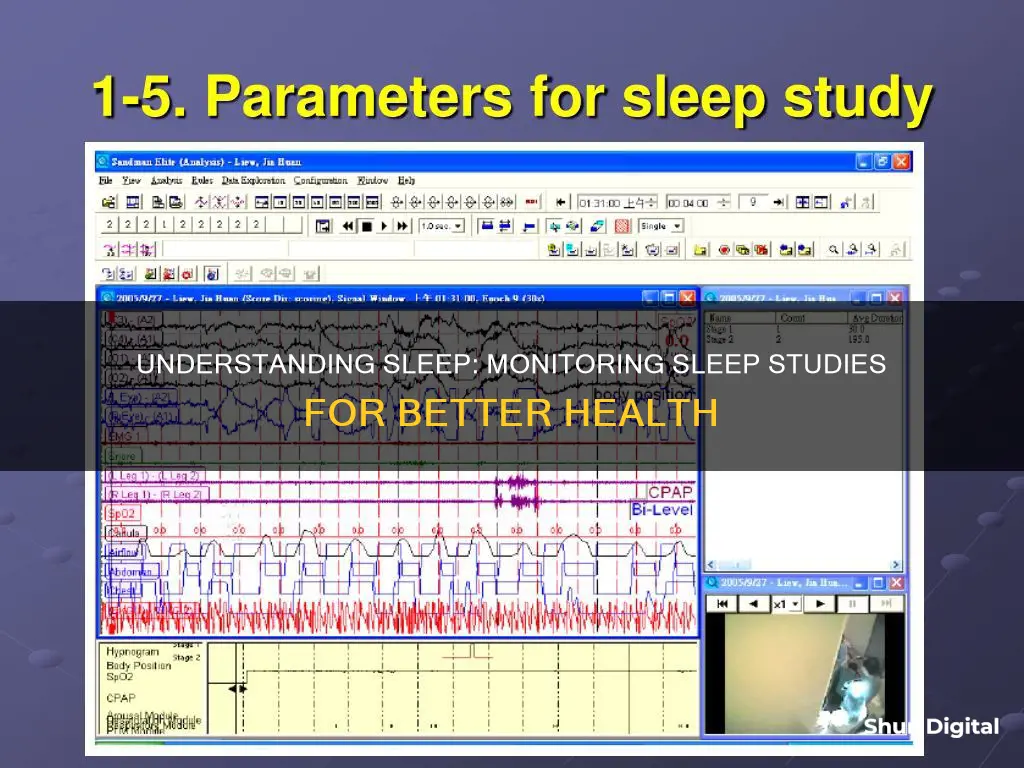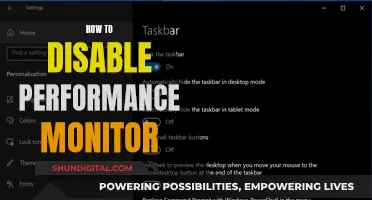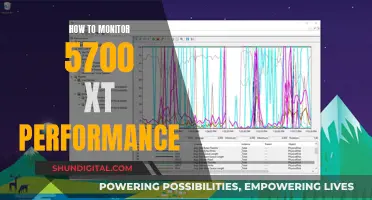
Sleep studies, or polysomnography, are a common diagnostic test that involves monitoring various physiological activities to gather data on sleep patterns and brain activity. The test is non-invasive and usually takes place overnight in a sleep lab that resembles a comfortable hotel room. It helps doctors diagnose and treat a variety of sleep disorders, including sleep apnea, restless legs syndrome, narcolepsy, insomnia, and REM sleep behaviour disorder. During a sleep study, various body functions are monitored, including brain activity, eye movement, heart rate, breathing patterns, oxygen levels, muscle contractions, and electrical impulses in the heart. The data collected from the sleep study is then evaluated by a doctor to determine the best treatment plan for improving sleep quality.
| Characteristics | Values |
|---|---|
| Brain Activity | Electrical currents of the brain |
| Eye Movement | Number of eye movements, frequency or speed |
| Muscle Movement | Number and intensity of movements |
| Heart Activity | Electrical activity of the heart |
| Heart Rate | Heart rate |
| Breathing Patterns | Number and depth of respirations |
| Oxygen Saturation | Percentage of oxygen in the blood |
| Acid/Base Balance of the Stomach | Amount of acid secreted during sleep |
| Sleep Latency | Time it takes to fall asleep |
| Sleep Duration | Period of time a person stays asleep |
| Sleep Efficiency | Ratio of the total time asleep to the total time in bed |
What You'll Learn

Brain activity
There are two main types of sleep: rapid eye movement (REM) sleep and non-REM sleep. Within non-REM sleep, there are three different stages. Each is linked to specific brain waves and neuronal activity.
During the first non-REM stage, the brain transitions from wakefulness to sleep, with brain waves slowing down from their active, wakefulness pattern. The second non-REM stage is characterised by a drop in body temperature, heartbeat, and breathing, with brain waves slowing down further. The third non-REM stage is the deep sleep stage, during which heart rate, breathing, and brain activity all drop to their lowest point.
REM sleep, also known as dream-filled light sleep, occurs about 90 minutes after falling asleep. It is characterised by rapid eye movements behind closed eyelids, with brain activity resembling that of wakefulness. Breathing becomes more rapid and irregular, and heart rate and blood pressure increase.
Throughout the night, the brain alternates between non-REM and REM sleep in 90-minute cycles, with longer and deeper REM periods occurring towards the morning. The cycle typically begins with 75-80 minutes of non-REM sleep, followed by 10-15 minutes of REM sleep.
In addition, REM sleep may play a role in forgetting or suppressing unimportant information. Research has identified neurons that produce a melanin-concentrating hormone (MCH) during REM sleep, which may help the brain actively forget new information and prevent dreams from being stored in the hippocampus.
Overall, brain activity during sleep is a complex and dynamic process that is vital for brain health, learning, and memory consolidation. By studying brain activity during sleep, scientists gain valuable insights into the functions and mechanisms of sleep, as well as the brain's overall functioning.
Performance Monitor: Capturing Data for Effective Analysis
You may want to see also

Eye movement
Non-rapid eye movement (NREM) sleep
During NREM sleep, eye movements slow down and eventually stop. NREM sleep is further divided into four stages:
- Stage one: the transition between being awake and falling asleep.
- Stage two: light sleep when the body temperature drops and heart rate and breathing regulate.
- Stages three: deep sleep.
Rapid eye movement (REM) sleep
REM sleep is characterised by rapid and ballistic medial-lateral movements of the eyes. The eyes remain closed but move rapidly from side to side. Dreaming and increased brain activity occur during REM sleep.
REM sleep is also known as "paradoxical sleep" because of its similarities to wakefulness. Although the body is paralysed, the brain acts as if it is awake, with cerebral neurons firing with the same intensity as in wakefulness.
REM sleep is further divided into phasic REM and tonic REM, which have different features in eye movements and EEG power spectra. Phasic REM is characterised by bursts of rapid eye movements, while tonic REM has fewer eye movements.
Experts are divided on why the eyes move as they do during REM sleep. Some research shows that these rapid eye movements enable people to change scenes while dreaming. Other studies suggest that the left and right eyes move separately.
Recent studies in both humans and rodents suggest that the eyes are an inner indicator of brain state during sleep. The eyes were found to be inner indicators of brain state during sleep, with pupil size dynamics coupled with sleep depth in mice.
A new study involving mice suggests that these eye movements occurring during REM sleep may not be random but could reflect a shift in the animal’s gaze while dreaming.
How I-130 Form Can Remove ICE Monitor Status
You may want to see also

Heart rate
During sleep, an individual cycles through different stages, including light sleep, deep sleep, and rapid eye movement (REM) sleep. Each stage is associated with distinct changes in heart rate. Within about five minutes of falling asleep, the heart rate gradually slows down as the body enters light sleep. During deep sleep, the heart rate reaches its lowest levels, approximately 20-30% below the resting heart rate. However, during REM sleep, the heart rate can vary significantly, increasing to levels similar to those experienced during wakefulness if the dream content is intense or involves physical activity.
Monitoring heart rate during sleep can help detect irregularities and anomalies, contributing to better overall health and sleep quality. It provides insights into the body's autonomic nervous system, which comprises the sympathetic nervous system (associated with the "fight-or-flight" response) and the parasympathetic nervous system (associated with a "calm-and-relaxed" state). The balance between these two systems influences heart rate patterns during sleep.
Furthermore, heart rate data collected during sleep studies can inform the development of models and algorithms for sleep stage detection and contribute to our understanding of the complex dynamics between sleep stages and heart rate regulation.
Connect Instruments to Alto TX210: A Beginner's Guide
You may want to see also

Blood oxygen levels
During sleep, it is normal for a person's breathing to become less consistent, with periods of slow or shallow breathing and short pauses. While these changes are normal, they can cause a temporary decrease in blood oxygen levels. Minor changes in blood oxygen levels during sleep are expected and usually nothing to worry about. However, if blood oxygen levels drop too low, this could be dangerous to a person's health as the body's tissues need oxygen to stay healthy.
Sleep apnea is a common disorder characterised by repeated gaps in breathing during sleep, which can lead to low blood oxygen levels. Obstructive sleep apnea (OSA) occurs when the throat muscles relax, blocking airflow into the trachea. Central sleep apnea is another form of sleep apnea where the brain fails to signal the muscles to breathe due to instability in the respiratory control centre. Untreated sleep apnea can increase the risk of high blood pressure, heart disease, and diabetes, making it crucial to diagnose and treat this condition promptly.
Overnight pulse oximetry is a simple test used to evaluate blood oxygen levels and identify sleep disorders like sleep apnea or more serious lung conditions. This test involves attaching a plastic clip called an oximeter to the fingertip, which measures the oxygen content of the blood. The data is recorded continuously throughout the night, and healthcare providers can review the results to identify any abnormal drops in oxygen levels. While overnight oximetry is widely available and easy to perform at home, it has limitations and may not detect all sleep disorders. Therefore, additional tests, such as polysomnography, may be necessary for a comprehensive diagnosis.
Blind Spot Monitoring: A Feature of Dodge Challenger?
You may want to see also

Body movement
Sleep studies are diagnostic tests that monitor multiple body systems, including body movement, to help diagnose sleep-related conditions. Body movement is monitored during a sleep study to gain a comprehensive view of the quality of sleep and identify any underlying issues.
Additionally, body movement monitoring can help distinguish between different stages of sleep. For example, during rapid eye movement (REM) sleep, the body becomes temporarily paralyzed, preventing individuals from acting out their dreams. In contrast, during non-rapid eye movement (Non-REM) sleep, particularly in the deeper stages, body movements may be more pronounced as individuals are not fully paralyzed.
The data collected from monitoring body movement during sleep studies can also be used to develop treatment plans or determine the need for further tests. This information aids in understanding the quality of sleep and identifying any abnormal movements that may interfere with restful sleep.
Overall, monitoring body movement during sleep studies is crucial for diagnosing sleep disorders, understanding sleep stages, and developing effective treatment plans to improve sleep quality.
Easy Ways to Find Your Asus Monitor's Serial Number
You may want to see also
Frequently asked questions
A sleep study, or polysomnography, monitors various body functions during sleep to help diagnose sleep disorders. This includes brain activity, eye movement, heart rate, breathing patterns, blood oxygen levels, body movements, and more.
Brain activity is monitored to record brain waves and identify sleep disorders and issues. Different types of brain waves occur during different stages of sleep, so this data helps to understand sleep patterns and quality.
Eye movements are monitored to understand their frequency and speed, as this data can indicate certain sleep disorders or disruptions in sleep.
Monitoring heart rate allows healthcare providers to check for any issues with the heart's beating pattern and internal electrical system. This data is important for diagnosing conditions that affect heart function.







